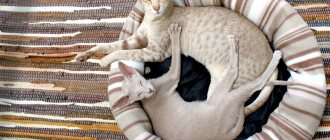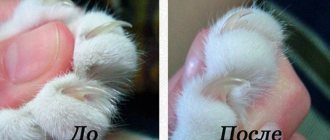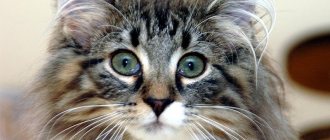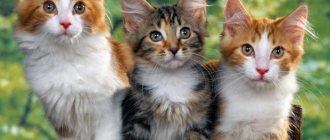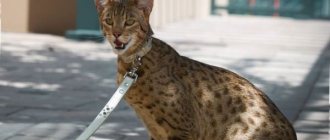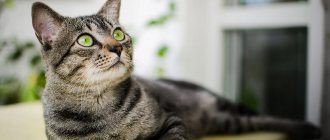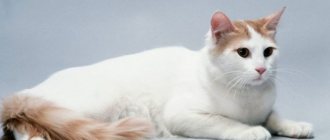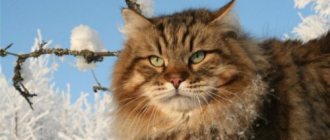History of the Oriental cat breed
Oriental cat
Genetically, oriental cats are close to the Siamese, with whom they began to be exported from Thailand in the 19th century. British breeders did not consider (or did not want to consider) green-eyed cats as an independent breed, so they classified them as a classic Siamese with a modified type of color. It is worth noting that at European exhibitions Orientals were not particularly favored, systematically disqualifying mustachioed emigrants either for non-standard colors or for the emerald shade of the iris.
The animals also did not arouse much interest among potential owners, so until the beginning of the 20th century, Oriental cats were bred only by enthusiasts who were passionate about breeding activities. The real crisis fell on the Thai Eared Cat in 1923, after the American Siamese Cat Club strictly tabooed the breeding of any variety of pets, with the exception of blue-eyed individuals with the Himalayan color.
For almost 30-odd years, Orientals were in limbo: they were expelled from the Siamese clan, but were never recognized as an independent breed. They remembered the cat only in the 60s by British and American breeders, who were carried away by the extreme appearance of animals. Initially, breeders planned to develop another variety of Siamese cat, which would have a uniform coat color, but would not lose the grace of its lines. To achieve this goal, Orientals began to be crossed with Abyssinians and other short-haired breeds.
1977 was a landmark year for Orientals, in which the wards of American breeders received their own standard of appearance. By the way, the first set of breed characteristics developed for overseas murkis was almost completely copied from the Siamese standard (with the exception of the points “body” and “colors”). But in Britain they were in no hurry to honor Asian cat breeds and spent 20 long years looking closely at them, scrupulously weighing the pros and cons. As a result, English long-eared cats were able to become an independent breed only in 1997, after official recognition by the GCCF.
Oriental cat with cat
Black oriental cat
Character of Orientals
These are very sociable, sociable, friendly animals with moderate activity and mobility. They love to be the center of a person’s attention and will demand attention to themselves, feeling its deficiency. Such cats are considered talkative; sometimes it may seem that they understand human speech and are even able to build a dialogue with their owner and family members. They are capable of producing a wide range of sounds - from hissing to loud purring. The Oriental breed has a developed level of intelligence, they are amenable to training and education.
Upbringing
Kittens understand simple commands well. If they do something unwanted, you can't say it loud enough or throw water at it. The animal will understand what is required of it and stop doing it. Kittens get used to the litter box very quickly; it’s enough to show him your litter box once and you won’t have to wait for any unpleasant surprises.
Oriental adult cat.
Training
Some owners often compare the intelligence of Oriental cats with dogs. They understand commands perfectly and learn them just as well as dogs, for example, “fetch”, “sit” or “voice”. The main thing is that the training takes place in a playful way, without punishment, physical and psychological pressure.
Appearance of an oriental cat
Orientals are typical Asians: graceful, lean, with the hypnotic power of a jade gaze. A distinctive feature of these charismatic pussies is their phenomenal plasticity of movements, thanks to which even ordinary stretching in their performance turns into a full-fledged yoga master class. Based on their coat type, Oriental cats are divided into short-haired and long-haired. The latter variety was born in the 60s of the last century as a result of crossing a shorthaired Oriental with a Balinese (Balinese cat). The Oriental Longhair was introduced as an independent breed in 1977, but it was only able to confirm its worth at exhibition competitions in 1997.
Head
Oriental kitten
According to the standard approved by the WCF (World Cat Federation), the head of an Oriental must have a flat forehead and a prominent profile. The muzzle of representatives of this breed should be narrow, and the chin line should be clearly defined. A mandatory item is the wedge-shaped shape of the skull.
Nose
Elongated, smooth. Located approximately in line with the chin.
Eyes
Almond-shaped, slightly slanting. The distance between the eyes is visually equal to the length of one of them. Regardless of coat color, all Orientals have rich emerald eyes. An exception to the general rule are white-haired individuals, whose iris color may be blue. Some cats have heterochromia (different eyes).
Ears
Quite massive in relation to the head. The ear flap is thin and wide, continuing the wedge-shaped line of the cat's muzzle. The tip is slightly rounded. The most intensive growth of the ears is observed in the first months of the animal’s life, which is why the Oriental kitten resembles a hybrid of Cheburashka and Yoda from Star Wars.
Neck
Graceful, elongated type.
Oriental cat face
Torso
Slender, noticeably elongated in length, with a well-developed muscle corset. The constitution of the body is close to lean: the animals look elegant and graceful.
Limbs
Oriental longhair cat
Oriental cats have extremely long limbs, giving their silhouette a slight aristocracy and grace. The animals' paws are oval and relatively small.
Tail
Whip-shaped, very long, with a sharp tip. The thickness of the tail is the same along its entire length.
Wool
Oriental cats have virtually no undercoat, allowing the fur to softly outline the contours of the body. The hair of short-haired individuals is shiny, satin-type. Long-haired animals have thin, silky hair. Since representatives of the second type have hair that fits tightly to the body, its real length is partially “lost.”
Color
Curled up into a ball
What the breeding experts were most loyal to were the color options for Orientals. Today, this is one of the few cat breeds that has the right to almost any shade of all existing ones.
In order to systematize the “colors” of eared cats, their basic types were identified by felinological associations. In particular, modern Oriental cats can have coats of such colors as:
- lilac (lavender);
- blue;
- red;
- Havana (brown);
- cinnamon (cinnamon);
- faun (beige);
- ebony (black);
- cream;
- white.
The preferred tabby colors are merle, brindle, ticked and spotted.
Defects and disqualifying defects of the breed
Serious defects that spoil the aristocratic appearance of Oriental cats include strabismus, any shade of the iris except green, as well as protruding and clearly palpable cartilage in the sternum area. As for exhibition events, first of all polydacts, very small or too thin individuals and cats with kinked tails will not be allowed to attend. The list of defective pets includes animals with insufficiently strong hind legs, spots on the fur in the form of medallions, as well as cats that breathe through their mouth. In the long-haired variety of Orientals, a double coat with a well-developed undercoat may be a reason for disqualification.
Breed characteristics
The height corresponds to the height of an average cat, up to 30 cm at the withers.
Weight can reach 4.5-5 kg, which is also comparable to the average size of cats. The cat of the Oriental breed is slightly larger than the female, sexual dimorphism is pronounced. The main distinguishing features of the breed are the elongated shape of the head, high pointed ears, and elongated slender paws. The Oriental cat may seem unusual to many people compared to other breeds. The shape of its muzzle is not to everyone’s taste; it is also unusual in its structure. The animal's muzzle has a straight profile and low-set ears. The body itself is thin, with close-fitting fur. However, all these differences (and for some they are serious disadvantages of the breed) are compensated by its character, disposition, and developed intelligence. Not all people like such features of a bright, memorable appearance, but thanks to this they become very noticeable.
Appearance of an oriental cat
The main characteristics of the description of the appearance of the Oriental breed can be called:
- Thin, fragile neck.
- Short-haired body with a close fit to the body.
- The head is medium in size, proportional to the size of the body. The head is characterized by a triangular shape, tapering towards the nose with a narrow chin. The nose is framed by a long and bushy mustache.
- The animal's forehead smoothly blends into the bridge of the nose, and the nose itself is wide and straight.
- The eyes are large and have a distinctive almond shape. The iris is often emerald in color, and in females it is light blue.
- Their ears are large, pointed, elongated. Distanced from each other, widely spaced, forming a common shape with the head. The base of the ears is wide.
- The chest has clearly developed muscles, especially in the front and hind legs. The muscles here are especially strong. The stomach is toned with well-developed abdominal muscles.
- The animal's legs are longer than those of an ordinary cat and have a rounded shape. The hind ones are longer than the front ones.
- The tail of such cats is long, thin, and has a rounded shape at the end. Its length can reach 80-90 cm.
- The animal's fur is thick, smooth, shiny with virtually no undercoat.
Snow-white Oriental with blue eyes.
There are subtypes of Oriental cats that have long hair. This breed appeared with the help of breeders from the USA. They appeared in the 80s of the last century. The Havana cat is one of the rarest and most exotic varieties of Orientals. In appearance, they resemble figurines made of beautiful expensive stone. The coat has a deep brown-chestnut color, evenly colored along the entire length of the hair. The eyes of such animals are always green. Little kittens are blue in color, but over time they turn green. The inheritance table for the breed's characteristics is presented below.
Gene inheritance table for Orientals and Siamese.
Orientals of extreme type are representatives of the breed that have pronounced features characteristic of all oriental animals. They have low-set ears and a very elongated muzzle. These cats differ from ordinary Orientals due to their bright appearance. The Oriental cat is an eye-catcher; they look like animals straight out of fairy tales. Many legends say that it was precisely such individuals that were revered in Ancient Egypt and were considered special animals there. The word “oriental” itself is translated into Russian as eastern. Compared to others, this breed is young, having common roots with Siamese cats.
Popular colors
The colors of Orientals are distinguished by their richness and diversity. There are more than forty types of coloring. They are characterized by the presence of stripes or spots that differ from the general coat color. The most popular colors are:
- Ebony. These cats look like miniature panthers, deep black in color. Individuals are considered one of the most attractive among breeders. The entire body is painted black, including the tip of the nose and the skin on the paws.
- Havana. It is a deep brown-chestnut color. The main difference is the emerald eyes. The skin on the body (nose, paws) is pink. This color is considered rare, and the waiting list in nurseries for such kittens can reach several years.
- Cinnamon. The wool is colored light brown. The eyes are green, the skin in areas free from fur is reddish-pink.
- Lilac or lavender. This is an unusual color, a mixture of gray and pink. Lilac Orientals have bright green eyes and a lilac nose.
- Faun. An animal with a characteristic beige (“deer”) coat color has a high value among breeders due to its rarity. Eyes – light green.
- Red or ginger. The fur of an Oriental cat is painted in a single color, there is no pattern or pattern.
- Tortoiseshell. An interesting type of coloring with evenly scattered spots over the entire surface of the body. This option is usually characteristic of females, the spots are red, gray or cream.
- White. The Oriental's coat is snow-white, without any other color interspersed. The skin is light pink. Up to a year, a kitten may have a spot of a different color on its head, which disappears as it grows. Often cats with white solid color have heterochromia (eyes of different colors).
- Cream. The fur is soft pastel colors, the skin in the free areas is pink.
- Marble. Spectacular, original coloring, emphasizing and expressing the grace and sophistication of the animal’s body, thin lines running from the animal’s head to its shoulders. The pattern can be in the form of parallel lines that are located along the back, and on the sides there are volumetric spots with a characteristic frame.
- Spotted. Such animals are distinguished by a large number of oval-shaped spots on the dorsal stripe.
- Tiger color. On the back there is a stripe from head to tail, on the rest there are chaotic lines on the sides of the body.
- Ticked. The coat may appear monochromatic, but upon closer inspection, it is clear that the hair has rings of light and dark colors.
There are also cats with patterned shiny colors, such as tortoiseshell or tabby. The base of the coat has a silver color, and the elements of the pattern have a clear contrast and expression.
Ebony
Havana
Cinnamon.
Lilac.
Faun.
Red.
Tortoiseshell.
Tortoiseshell.
Cream.
White solid.
Ticked.
Breed standards and defects
The standards for this breed are the following:
- The animal has an elongated body, long legs and a tail. The body itself has a thin skeleton, it is graceful, proportional, and athletic. The tail is long and thin, resembling a whip.
- The chest protrudes, sometimes having the shape of a keel. The weight of an adult cat reaches 6 kg, and that of a female cat 4.5 kg.
- The head of the Oriental is triangular, with equal sides, if you count at the extreme points of the ears and chin. The shape of the head is slightly flattened, with a smooth transition between the forehead and nose.
- Large almond-shaped eyes, color depends on coat color, but the most common color is green, emerald green, blue. A discrepancy between the coat color and the eye color is a reason for the disqualification of an individual or deprivation of its rights to participate in exhibitions. Strabismus is considered the same defect.
- Wide profile, straight and long nose. Kittens may have a sunken bridge of the nose, but this will gradually go away.
- The ears are large, triangular, with the bases widely spaced from each other. The placement of the ears should correspond to the shape of a triangle along with the head.
- The Oriental's paws are long, thin, and slightly rounded.
- The animal's coat can be long (oriental longhair) or short, lying close to the body; the undercoat is absent or weakly expressed.
The long-haired Oriental cat has a straight forehead, no bulges on the skull near the eye sockets. They have an elongated nose, which should form a straight line with the forehead. The ears are large, like those of a shorthaired Oriental. If their size is not proportional to the head, the animal is disqualified and is not recognized as a true “Asian”. The rarest and most valuable colors are blue and copper. If the pet meets all these requirements, then we can talk about the animal being purebred and having a good pedigree.
Material on the topic: what to feed Scottish cats.
Photos of oriental cats
Character of an oriental cat
If, when buying a baby Oriental cat, you expect to receive an arrogant sofa Buddha in the future, do not hope - the Asian mentality in these cats is sleeping soundly. Purebred Orientals are quite sociable and playful pets, madly in love with their owner. Eastern arrogance and detachment are absolutely not characteristic of them.
Oriental cat during play
Oriental cats are characterized by dog-like behavior. This means that wherever the owner goes, the “wool Yodas” will definitely attach themselves to the side to control his every step. Consider the fact that you will only dream of peace with these perpetual motion machines, jumpers and runners. Sofas for oriental cats are not a habitat, but a convenient springboard from which it is so convenient to “fly up” onto a closet, chest of drawers or cornice. Conquering heights, to which cats so selflessly devote themselves, brings with it inevitable destruction in the interior, therefore, if a vase broken by a pet can seriously spoil your mood, it is better not to get an oriental cat.
Oriental cats are inveterate gambling addicts, and this addiction cannot be treated, so buy your pet more wind-up mice, teasers and balls - let him have fun for his own pleasure. With age, Orientals do not lose interest in games, so even older individuals enjoy chasing candy wrappers and paper balls around the floor. Another characteristic feature of the breed is its burning curiosity. Oriental cats simply cannot stand secrets, no matter how insignificant they may be. The contents of any closed container are subject to thorough inspection, and slammed doors to another room are completely regarded as a military secret that must be revealed at all costs.
Skoda
Oriental cats are very dependent on human attention. They can hardly tolerate loneliness, so before buying a Thai long-eared dog, you should think carefully about who will stay with the pet while you are at work. As for the annoying meowing, which many owners of Orientals complain about, it really does occur, so the “talkativeness” of the breed will have to be taken for granted. But the timbre of the voice of these kitties is more pleasant than that of the same Siamese.
Most Oriental cats have a bright personality. For example, some individuals are not very friendly towards children, while others, on the contrary, treat the younger generation with great condescension. Orientals get along well with other cats. But they may experience a slight mistrust of dogs, which passes over time. According to experts, the green-eyed “Asian” should not be the only pet in the house, because the presence of other animals in the room helps him endure separation from his owner less painfully.
Oriental in the hands of the owner
Negotiation
History of the breed
The distant nineteenth century, foggy Albion, it was here that such breeds of cats as Siamese and Oriental were brought from the mysterious kingdom of Siam (modern Thailand). But the prim British, who unconditionally recognized the Siamese, did not see anything interesting in the Oriental cats, rendering a verdict that the Oriental cats were just an unsuccessful offspring of the Siamese.
But cats of the oriental “eastern” breed were mentioned in ancient Thai manuscripts and even then were considered a separate breed of animals. In them you can read a description of the breed: sleek cats with coat of the same color and large ears. For a very long time, the Oriental cat (oriental, shorthair) was considered restricted from traveling abroad; they were bred only in their homeland, and until the end of the 19th century, the import of animals to the countries of the Old World was strictly prohibited.
But fortunately, Oriental cats, having not received recognition in England, were brought to America, where they managed not only to preserve the originality of the breed, but also to achieve official status. All these actions took more than sixty years from the moment that short-haired cats with a single color were presented at an exhibition in England.
Only in the seventies of the last century, the short-haired cat of the Oriental breed received worldwide recognition from felinologists around the world. A little later, breeders began crossing animals to produce offspring with long fur. And at the very end of the nineties, the long-haired oriental cat also received recognition and a champion title in the CFA.
In Russia, the “short-haired oriental cat” breed became known in 1987 and very quickly gained popularity and many fans among cat lovers.
Training and education
Walking an oriental cat on a leash
Orientals inherited from their Thai ancestors a lively, sharp mind and excellent learning abilities. In particular, it is easy to “train” a cat to fetch objects, as well as to carry out simple commands. As for the basics of etiquette, their pet will have to be instilled, because, despite the fairly high level of intelligence, oriental cats are capable of minor dirty tricks. For example, little eared cats love to swing on curtains and dig into flower pots. They do this not out of harm, but out of thoughtlessness, so it is very important to immediately point out to the kitten that such behavior is unacceptable.
Punishing, let alone beating, an animal is the last thing. An Oriental cat can easily guess about its own mistakes, relying only on the intonation of your voice, so use this quality to its full potential. Sternly shout at the mustachioed lawless man walking around the table and hiss expressively at the kitten climbing the curtains. You can be sure that the pet will intuitively understand what they want from him.
A common mistake that can negate the results of all your efforts is periodic exceptions to the established rules. As an example: today a serious reprimand has been given to the kitten jumping on the table, and tomorrow you are filming a video for YouTube where the tiny Cheburashka is briskly climbing the tablecloth to your encouraging comments.
Content Features
You should care for your cat's eyes daily - remove secretions from the tear ducts with cotton wool or a damp soft cloth.
When cleaning the ears, you need to be especially careful, since the ears of Orientals are delicate and the skin can be easily damaged. It is recommended to moisten a cotton swab in oil (vaseline or vegetable); you also need to check the softness of the cotton swab so that the sharp end does not scratch the skin. Only the visible part of the ear should be cleaned.
Teeth should be brushed regularly, as Orientals are susceptible to oral diseases. You should also give your pet special treats to chew on.
Nails should be trimmed every month using nail clippers or tweezers. No more than 2 mm of the claw should be removed at a time, but it is better to cut less so as not to touch the vessel.
It must be remembered that show cats require more intensive care and, most likely, you will often have to use the services of professionals. If you are not going to take your pet to shows or breed cats, then you can limit yourself to basic care rules. We must not forget about regular visits to the veterinarian so that the pet is always healthy.
Maintenance and care
Oriental cats do not require any special or labor-intensive care. Thai long-eared cats prefer to take care of the cleanliness of their fur themselves, which, by the way, they do quite well. The owner just has to buy a rubber mitten to clean off loose hairs from the pet’s body during seasonal shedding. The same procedure can be carried out using an ordinary damp cloth: shedding wool easily sticks to damp matter. It is generally not recommended to bathe Orientals. An exception can only be made for an animal that is too dirty or for individuals preparing for an exhibition.
Sleepy kingdom
Cats have their ears cleaned no more than once a week. No special equipment is required for this procedure, except for a cotton swab and disinfectant lotion, which can equally well replace regular Vaseline. Regularly examine your pet's eyes, removing accumulated dirt and mucus with a cotton pad soaked in boiled water. Ideally, Oriental cats should also have their teeth brushed, but in practice, few owners want to participate in this painstaking process. If for some reason you are unable to treat your pet’s oral cavity, try to minimize the risk of plaque and tartar by purchasing dry food. Densely pressed “drying” croquettes do a good job of cleaning teeth and are quite capable of replacing a regular brush. For animals that eat wet canned food, you can buy special veterinary treats for dental plaque (sausages and bones for dogs are suitable).
Caring for an Oriental cat's claws begins with the purchase of a scratching post. But since the nail plate of representatives of this breed grows quite intensively, once a month they should have a “pedicure” session. Shorten the claw by no more than 2 mm, otherwise there is a risk of injuring your pet’s skin. If the cat actively resists during the process, it is better to involve an assistant in the matter and stretch out the “pleasure” for several days.
Orientals have one not very pleasant trait - they love to taste indoor flowers. If a green-eyed kitten of this breed appears in your home, it is better to remove Dieffenbachias, azaleas and other plants that are poisonous to cats from his field of vision. The same applies to open windows. For the gutta-percha “Asian”, falling out of them is a matter of a few seconds.
Feeding
You won’t be able to save money on buying industrial food with oriental: the digestive system of the lop-eared “Thais” is simply not able to properly digest the food from your table. So, in the case of food, the owner of an Oriental cat has only two options: treat the pet with wet canned food or transfer it to “drying”. By the way, cats themselves prefer the first option, while their owners are more focused on dry food, which is cheaper and lasts longer. If you want to please your pet, but not at the expense of your own comfort, try alternating between canned food and dry food. The only thing you shouldn’t do is mix both types of food in one feeding.
Within Temptation
Sometimes an eared cat can be pampered with natural products, for example, a piece of lean meat, fish fillet, or oatmeal with milk. But you shouldn’t organize such belly celebrations too often. Firstly, the pet will quickly get used to the treats, which can lead to a loss of interest in commercial food. Secondly, such gluttony leads to obesity, to which Orientals are already prone. The cat's daily menu should not be very varied, so that the animal is not tempted to eat in reserve. Choose a suitable type of premium food for your mustachioed friend (options for Siamese cats are suitable) and do not deviate from the set course.
Oriental merle cat
Note: you can determine how suitable a particular type of food is for a cat by the condition of its fur. A soft, glossy coat without signs of dandruff indicates that the diet has been chosen correctly.
To discourage your Oriental cat from overeating, always leave enough food in her bowl. It is undesirable to feed an animal on a schedule, since pets regard this as the threshold of a serious hunger strike and consume more food than they need.
For the normal functioning of all body systems, it is useful to mix vitamin-mineral complexes into the food of Orientals. In particular, calcium and taurine supplements are recommended for young individuals. And of course, do not forget to provide the animal with round-the-clock access to clean water.
Toilet
Orientals are very smart and clean cats. Usually 3-month-old babies from the nursery already know what a tray is and how to use it correctly. If the kitten stubbornly continues to walk past the toilet, it is important to understand that he is not doing this out of harm. The tray may be in the wrong place. For example, if the toilet is located in the bathroom, the animal may be irritated by the smell of household chemicals.
It is better if the tray is in a secluded corner where no one will see the baby and where he can truly relax. A kitten sitting down to relieve itself in the wrong place must be frightened, but this should be done in such a way that the animal does not understand that the source of the threat is the owner. For example, you can clap your hands loudly, spray the Oriental cat with water from a spray bottle, or throw some kind of soft toy at it.
Variations of tortoiseshell colors in cats
It is impossible to find two identical tortoiseshell cats. This is due not only to the individual arrangement of colored hairs on the animal’s body, but also to the different subspecies of tortoiseshell color. Breeders have divided the tricolor colors into three variants to avoid causing confusion.
Table 1. Tortoiseshell colors: options
| "Cake" | "Calico" | Turtle on white |
| Otherwise, this subspecies is called the “scaly turtle.” The coloring of tortie cats is similar to small fish scales, colored red and black, and placed on top of each other in a checkerboard pattern. Of course, the geometric precision of the coloring of cats is extremely rare, but the distinctive feature of this subspecies of color is the approximately equal ratio of black and red, as well as a small, motley pattern created by multi-colored hairs. | This subspecies is also called “calico” or “patchwork”. Calico-colored cats have larger spots - that is, not individually colored hairs, but small areas of fur, colored either black or red. The spots can creep on top of each other, be randomly located or in groups. Calico cats with short hair (British, Cornish Rex) or even without a fur coat (Canadian Sphynx) look very impressive. | If the color of the animal contains a large amount of white fur, this subspecies is called “turtle on white.” Typically, cats have large snow-white patches of fur on the tummy, in the groin area, on the bottom of the neck, near the chin or on the face. The upper part of the body has a tortoiseshell color, while the “tortoise on white” can be either a “calico” or “torti” variation. These cats look very attractive and cute. |
Color "tortoiseshell on white", type "calico"
Tortoiseshell colors come in two types: solid or patterned. In the first case, the spots will be located evenly on the animal’s body, without forming patterns or patterns. The patterned version assumes that spirals, stripes, and “marble veins” are clearly visible on the cat’s fur. Patterned cats can be either short-haired cats (then the pattern is clearly visible) or long-haired cats (to see the pattern, you need to part the animal’s fur and look at the skin, which will also be colored).
Also, “turtles” can have different shades. Yes, the main colors will be black and red, and perhaps, looking at one tortoiseshell cat, these colors will seem to be the only possible ones. But if you put two, or better yet several, turtle cats together, you will see that the black color looks coffee or chocolate, has a bluish or graphite-gray tint. It’s the same with red – it shimmers with shades of honey, caramel, sunny orange or gives a creamy tint.
Tortoiseshell cat with very bright shades of fur
Why then were motley cats called tortoiseshells? The fact is that the fur of animals with this color is surprisingly similar to products made from a tortoise shell, sanded and varnished. It’s worth looking at tortoiseshell combs or other accessories to understand what exactly gave the name to the unusually beautiful coloring of the cat’s fur.
Tortoise shell hair comb
Health and diseases of Oriental cats
Handsome men
Despite the fact that the average life expectancy of Orientals is 15-17 years, they cannot be called real big guys. By inheritance from Siamese ancestors, cats have inherited a whole set of genetic ailments that significantly complicate their lives. Many individuals are diagnosed with liver amyloidosis, which, if not treated promptly, can cause liver failure. Another scourge of the breed is myocardial disease (dilated cardiomyopathy), so the animal must undergo ultrasound diagnostics at least once every six months.
Eye problems among Oriental cats are also quite common. Most often, “Thais” suffer from strabismus and progressive retinal atrophy. In addition, there is always a risk of kittens being born with flat chest syndrome. If the disease is not recognized and treated in time, the baby’s lungs will not be able to work at full capacity, and he will simply suffocate.
A little about the character of the eastern cat
The character of such an animal is a separate issue. Who yells loudly for any reason, who never lags behind his master, who constantly wants to be the center of attention? Of course, the kitten is an Oriental breed, and this character is completely preserved in adults.
These pussies scream constantly, any action: playing, going to the toilet, eating must be loudly commented on. The animal also indicates its mood by shouting: it screams if it is sad, it meows in a deep voice if it is about to have fun.
Attention from the owner is the main thing this cat needs. Oriental cats are terribly energetic and curious. These animals simply cannot lie in a dark corner for hours. They constantly need movement, any object in the apartment: the owner’s legs, a piece of paper forgotten on the table, a sunbeam or a small fluff immediately becomes an interesting toy that simply must be caught.
INTERESTING TO KNOW: The smartest breed of Savannah cats
These fidgets are not at all afraid of heights. Cornices, cabinets, doors and curtains - this is where you will have to remove the kitten almost every day. Such a cat seems to be made of durable rubber, which means it can easily and without problems jump anywhere.
Pussies of this breed are very friendly, they are ready to play not only with their owners, they are happy to pay attention to guests, and are not at all afraid of strangers. But an oriental beauty can be very offended and even harbor a grudge against a certain person; she inherited this character trait from a close relative - a Siamese cat.
How to choose a kitten
When buying an Oriental breed kitten, be sure to ask about its age. Nurseries that value their own reputation do not sell animals that are under 3 months old. When assessing the conditions in which babies are kept, pay attention to whether the breeder has cages in which unscrupulous sellers often lock their charges. Experienced specialists who love their work raise kittens in a home environment: they play with them, they are not put in an enclosure and are not limited in communication with other pets. Accordingly, such individuals will undergo socialization faster.
Oriental kittens with mother
Its appearance will also help to assess the health of an Oriental kitten. Eared cats with matted fur, discharge from the eyes and nose, and bloated bellies will bring nothing but problems. Any kitten purchased from a cattery must have a metric or pedigree. If there are none, then, most likely, under the guise of a purebred Oriental, they are trying to give you a mestizo. Sometimes breeders explain the lack of documents for a kitten as an unplanned mating, although this is nothing more than excuses and attempts to hide the truth about the true origin of the animal.
Those who plan to breed their pet in the future and get offspring from it should look into nurseries that sell breed-class oriental cats with impressive pedigrees. If you do not intend to breed kittens for sale, visit places where they breed orientals without breeding rights. Most of these nurseries offer already castrated or sterilized kittens.
Some breeders have a negative attitude towards early sterilization, which can seriously affect the external parameters of the cat, and do not carry out this procedure. In this case, all responsibility for the reproductive function of the pet falls on the future owner. Usually, before the sale, the buyer signs an agreement according to which he undertakes to spay/neuter the kitten as soon as it is 8-12 months old.
Special color
White - the coat is completely white without any yellowness.
There are 3 types of white orientals: white with green eyes - solid white; white color with blue eyes; white color, eyes of different colors, one green, the other blue.
Blue eye color in white cats can appear under the influence of the W (White dominant) allele. A kitten may be born with or without a small spot (“cap”) on its head. If a white blue-eyed cat did not have a “hat” in childhood, then conclusions about its genetic belonging to the Siamese breed can only be drawn by crossing with Siamese cats.
With a white color, up to one year there may be a colored spot on the head, which then disappears. The tip of the nose and paw pads are pink. The eyes are blue (foreign white), green or of different colors (one is blue, the other is green).
